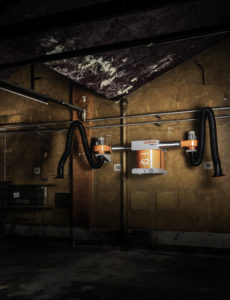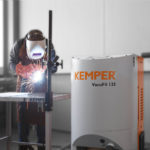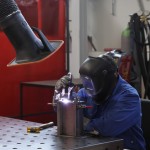Save energy, protect employees
The costs of oil, gas and electricity are currently rising to record levels – and posing major challenges for industrial companies. High time, then, to identify energy guzzlers in production. Modernisation or retrofitting can often increase the efficiency of systems and machines. Once this potential is exhausted, new acquisitions come into play.
Not only do cutting edge suction and filter units from KEMPER offer better protection against dangerous welding fumes, they also help reduce energy costs in production. Energy savings of up to 30 percent are possible. Cost-effective retrofitting of existing suction and filter units also harbours great savings potential.
Recirculated air instead of exhaust air
For example, by switching from exhaust air to recirculated air, i.e. if a retrofit is used to return the heated hall air to the room in a purified state, several thousand kilowatt hours of energy per heating period (15 October to 15 April) can be saved. In exhaust air operation, an extraction arm with 1,000 cbm/h causes an energy loss of approximately 4,100 kWh per heating period. This energy loss can be prevented by retrofitting from exhaust air to recirculated air. According to calculations by KEMPER, this is equivalent to a saving per extraction arm of approximately 375 litres of heating oil or 406 cubic metres of low calorific natural gas. In order to convert an existing exhaust air set into a recirculation unit, KEMPER recommends the mechanical WallMaster filter. The WallMaster also works on extraction elements from other manufacturers.
 Changing the filter reduces energy consumption
Changing the filter reduces energy consumption
Regular maintenance, which can be carried out with the annual safety check, offers further savings potential. This means that devices and systems always remain up to date. Changing a filter when due also reduces the energy consumption in an extraction system, because contaminated filters increase the resistance of the air flow, and suction and filter units with old filters consume more energy as a result.
Quiet and powerful
Automatic control of the extraction capacity also leads to energy savings. It reduces the power consumption of the suction and filter unit, and hence the running costs. The integrated frequency converter permanently adjusts the motor speed and power consumption to current demand. The suction and filter unit usually runs, therefore, in a partial load range at a comfortable temperature during operation. The maximum motor power is only ever called up on rare occasions, because central extraction systems for several workplaces do not permanently require the maximum power. Here is an example: If the system reduces the motor speed by 20 percent, energy consumption drops overproportionally by 50 percent. Adjusting the motor power also significantly reduces noise emissions. A double win for the employees: They work in an environment that is virtually free of welding fumes, and their hearing is protected by lower noise exposure.
Reduced starting current
Another benefit of a welding fume extraction system with frequency converter is that the current consumption does not exceed the rated current of the motor. The starting current is reduced which means less power is consumed. In addition, the frequency converter increases the efficiency of the system by adjusting to the individual properties of the motor. This can save a further three to four percent of energy.
Increasing the service life of the system
Despite the reduced starting current, the extraction capacity remains constant at all workplaces, regardless of the utilisation of the welding station. By starting the motor slowly, the advanced filter system helps protect the electrical components, increases the service life and reduces the maintenance effort. In addition, a suction and filter unit from KEMPER has a filter cleaning system using rotating nozzles. It conserves the material and thus also resources. Companies can save the costs of expensive spare parts while contributing to climate protection at the same time.





